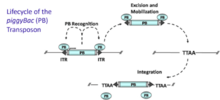PiggyBac Transposon System
| PiggyBac Transposon System | |
|---|---|
 PiggyBac Transposon System |
The PiggyBac (PB) transposon is a mobile genetic element that efficiently transposes between vectors and chromosomes via a "cut and paste" mechanism. During transposition, the PB transposase recognizes transposon-specific inverted terminal repeat sequences (ITRs) located on both ends of the transposon vector and efficiently moves the contents from the original sites and efficiently integrates them into TTAA chromosomal sites. The powerful activity of the PiggyBac transposon system enables genes of interest between the two ITRs in the PB vector to be easily mobilized into target genomes. The TTAA-specific transposon piggyBac is rapidly becoming a highly useful transposon for genetic engineering of a wide variety of species, particularly insects.[1]
Origin
The TTAA-specific, short repeat elements are a group of transposons that share similarity of structure and properties of movement. These elements were originally defined in the Cabbage Looper,[2] but appear to be common among other animals as well. They might prove to be useful tools for the transformation of insects. The original identification of these unusual TTAA-specific elements came through a somewhat unconventional route relative to most other Class II mobile elements. Spontaneous plaque morphology mutants of baculoviruses were observed to arise during propagation of these viruses in the TN-368 cell line. Genetic characterization of these mutations often revealed an associated insertion of host-derived DNAs, some of which appeared to be transposons.
Several different mobile host DNA insertions have been identified within the few-polyhedra (FP) locus of the baculoviruses AcMNPV and GmMNPV. The insertions most extensively studied are those now designated as tagalong (formerly TFP3) and piggyBac (formerly IFP2). These insertions exhibit a unique preference for TTAA target sites, whether inserting within the viral FP-locus or at other regions of the viral genome. Both of these elements are part of a larger family of TTAA-target site specific insertion elements that includes the T. ni derived piggyBac and tagalong elements, the Spodoptera frugiperda derived elements IFP1.6 and 290 bp insertion of Carstens, and the transposon-like insertion within the EcoRI-J,N region of Autographa californica nuclear polyhedrosis virus, whose origin is undefined.
More recently, analysis of sequences obtained from the human genome has revealed what appear to be 100 to 500 copies of a fossil element called LOOPER, which has sequence homology to piggyBac, terminates in 5' CCY....GGG 3', and apparently targets TTAA insertion sites. The LOOPER consensus sequence is on average 77% similar to individual sequences identified in the human genome, indicating it is at least 60 million years old. There are two other TTAA-specific fossil repeat elements, MER75 and MER85 (estimated at 2000 copies per genome) which appear to target TTAA insertion sites and terminate in 5' CCC....GGG 3'. Evidence is accumulating that suggests a superfamily of TTAA-specific mobile elements exists in a diversity of organisms, and that piggyBac-related sequences may be present in a diversity of species.[3]
Nomenclature
These elements were first identified as insertions in Baculovirus mutants by Dr. Malcolm Fraser,[3] professor at the University of Notre Dame, and were originally named as IFP for Insertions in FP mutants. The name was then changed to TFP for Transposon in FP. Finally the name PiggyBac was adopted to keep the interest of the audience and to bear some resemblance to Drosophila gene nomenclature.
References
- ↑ "Piggybac Transposon System". Transposagen Biopharmaceuticals, Inc.
- ↑ Fraser, MJ; Smith, GE; Summers, MD (Aug 1983). "Acquisition of Host Cell DNA Sequences by Baculoviruses: Relationship Between Host DNA Insertions and FP Mutants of Autographa californica and Galleria mellonella Nuclear Polyhedrosis Viruses.". Journal of Virology. 47 (2): 287–300. PMC 255260
 . PMID 16789244.
. PMID 16789244. - 1 2 Fraser, Mac. "PiggyBac". Mac Fraser.
External links
- piggyBac technology page at Transposagen Biopharmaceuticals, Inc.
- Optimized all-in-one piggyBac transposon system from DNA2.0, Inc.
- piggyBac transposon system from Systems Biosciences, Inc.